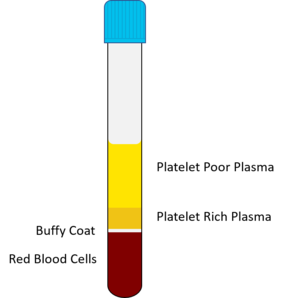Platelet Rich Plasma Injection
Platelet rich plasma (PRP) is an autologous blood product, with platelet levels at a higher level than baseline. The patient's blood is extracted, anticoagulated, spun down in a centrifuge, the PRP is extracted, and then injected. Platelets are involved in tissue repair through the release of growth factors. The centrifugation process can be done via a single-spin, or double-spin process for higher platelet concentrations. The activation varies between research protocols, some authors prefer activated PRP, while others prefer inactivated PRP. The final platelet concentration, described in terms of times (e.g. 5x), varies between protocols, PRP cartridge kits, the age, and co-morbidities of the patient. However a higher platelet concentration is not necessarily more effective. The procedure can be repeated. [1]
Definitions
- Pure PRP (P-PRP): Has a low leucocyte content, and is injected as a liquid or gel
- Leucocyte-rich PRP (L-PRP): Higher platelet concentration than P-PRP, and can also be injected as an activated gel or liquid
- Pure platelet-rich fibrin (P-PRF): A platelet-rich fibrin scaffold, obtained by double-spinning centrifugation. This is stiffer than normal PRP and is in a gel form.
- Leucocyte- and platelet-rich fibrin (L-PRF): A non-injectable leucocyte-rich gel
Indications
Tendinopathy, mild osteoarthritis, cartilage tears etc
Contraindications
Blood disorders or platelet dysfunction. Haemoglobin level below 100, tumour in wound bed, metastatic disease, active infection. [1]
Risks
infection, bleed, nerve damage all rare
Pre-procedure Instructions
Stop NSAIDs and potentially anti-platelet prior to and just after (as long as not contraindicated to stop).
Procedure
Equipment
Procedure described for doing one leukocyte rich and one leukocyte poor injection.
- Syringes
- 60mL syringe for the blood
- 10mL syringe for the local anaesthetic
- 10mL syringe for the leukocyte poor PRP
- 10mL syringe for the leukocyte rich PRP
- Needles
- butterfly set for taking blood
- drawing up needle
- 25g needle for the local anaesthetic
- Needle for the PRP injection e.g. 22g 70mm spinal needle for the hip joint.
- ACDA anticoagulant
- PRP kit
- One cartridge for the blood
- Another cartridge as a counterbalance, measured to weigh the same, filled with water.
- Centrifuge
- Sterile ultrasound jelly
- Ultrasound machine
- PRP benchtop processing station.
Preparation
- Put ~2.5mL of ACDA into the 60mL syringe
- Draw up 55mL of blood into the 60mL syringe
- Place the drawing up syringe onto the syringe, open the top of the cartridge, and then transfer the mixed blood/ACDA solution. Close the top
- Place the cartridge into the centrifuge, along with an equal counterweight cartridge.
- Spin at 3350rpm for 7 minutes
- Remove the cartridge, it should be separated into red cells at the bottom, leukocytes in the middle, and plasma at the top
- Place the cartridge into the PRP benchtop processing station, facing up
- Use the dial on the station to control the plunger
- Remove and discard the top half of the plasma which is called platelet poor plasma.
- The remaining plasma is leukocyte poor at the top, and leukocyte rich at the bottom. The very bottom of the plasma has the leukocytes which is called the buffy coat.
- Transfer the top remaining half (leukocyte poor) into a 10mL syringe
- Transfer the bottom remaining half, including some of the leukocytes into another 10mL syringe.
Procedure
- Joint
- Infiltrate the skin and capsule with local anaesthetic but not the joint space
- Inject into the joint space or joint structure with the leukocyte poor solution
- Tendon
- Inject around the tendon with the leukocyte rich solution
Aftercare
- Leukocyte rich PRP can cause a pain flare for a few days.
- Advise to wait for minimum 4 weeks before assessing efficacy.
- Use joint gently after procedure (e.g. low resistance cycling).
- 3 x injections for maximal effect
- Stop NSAIDs and potentially anti-platelet prior to and just after (as long as not contraindicated to stop).
Resources
{{#l:Platelet-rich plasma (PRP) for knee disorders.pdf}}





